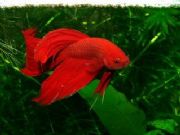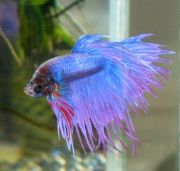Article categories:
Select a category below to view articles on each subject.
Search
Enter your keyword/s below to search :

Fish delivered straight to your door from Wildwoods
Hundreds of Species available today…
TFF Mailing List
Join the TFF mailing list today and we will email you with latest offers, news items and more.
Bettas: Who Make the ‘betta’ Tank Mates?
Bettas (commonly known as siamese fighting fish) are one of the most popular fish in the world of fish-keeping. They are native to Thailand, Cambodia, Vietnam and Laos. The name ‘betta’ refers to around 70 species of fish and they are part of the gourami family. Known for their captivating beauty, iridescent colours and aggressive nature, these territorial omnivores can actually breathe outside of water for short periods of time due to an organ they possess called a labyrinth.
Female and male bettas are easy to distinguish due to males being much brighter and larger finned. Males are the more popular amongst aquarists due to their eye catching/ dramatic appearance with elaborate ballgown-like fins and deeply coloured vibrant bodies of red, green and blue. Funnily enough, wild bettas are actually much duller looking than the ones we see in our aquatic shops today- often presenting with lustreless brown and green hues. Part of the fascination behind bettas are their difference in tail shape e.g. delta, crown, double feather, half-moon etc…
It is a common misconception that all bettas must only be kept as solitary fish due to the fear that they may live up to their name (fighter fish) and harm other tank-mates. This is a shame because actually bettas are quite intelligent and if given the opportunity may even learn to recognise their owners and perform tricks! Although one may find it difficult to find a suitable friend(s) for their betta, it is not impossible to find some fish and invertebrates who will coexist with a betta harmoniously. It is important to note that there are lots of fish to avoid when choosing a tank-mate for your betta. As a general rule of thumb, fish to avoid are those that fall into any of the categories below:
-A second male betta.
-Fin biting fish (bettas have long flowing fins and wouldn’t take well to fin nippers.)
-Colour-rich fish (these may cause stress/ aggression with the betta who may confuse the tank-mate for a rival betta.)
-Fish which require a bigger size tank that where the betta already resides.
-Fish which require different water parameters/ conditions to the betta (which requires soft, slightly acidic water with a ph 6.8-7.4)
-Fish which inhibit the same area as the betta (mid-top of the tank.)
Warning: Every Betta is different. Some will have a personality which results in them simply not wanting to live harmoniously with any other species. Even if you know someone else who has been successful, it doesn’t mean your betta will react the same…It is worth having a plan of action incase the new tank mates are not getting on well with the betta.
Here is a list of our top 5 tank mates for the lovely betta splendens:
1. Shrimp (Amano/Ghost/Cherry) - Unobtrusive and good at hiding. Also great algae eaters.
2. Snails (Zebra/Mystery) - Peaceful and very unlikely to reproduce in a freshwater tank. Another great algae eater.
3. Pleco (Clown/Bristlenose) - Bottom dwellers, easy to care for and the Bristlenose variety are armoured with tough plates therefore difficult to scare. Also a great algae eater.
4. Catfish (Corydoras) - Easy to care for, hardy, bottom feeders, peaceful but also active and pleasurable to watch.
5. Frogs (African Dwarf) - The success of this combination will depend on the temperament of the betta and frog. Generally, people find these frogs to be peaceful, active and playful. They require a similar diet to the betta so just be careful the frog gets enough food or they may become upset.
The Bonus Tank Mate: Marimo Moss Balls - Low cost, decorative, hardy, reduce ammonia/algae/nitrates, produce oxygen, very low maintenance. Bettas love relaxing on their velvety green decorative moss balls and even playing football with them! Another plus is that other tank mates (especially shrimp) adore marimo moss balls and often use them as a hiding place or as a place to eat food which is trapped between the fibres.
N.B Don’t forget to keep your betta happy and healthy by providing him with:
-Plenty of space (a single betta needs a minimum of 5 gallons and this is also the volume required to establish your nitrogen cycle with ease.)
-Keep the water warmed to around 26C.
-Install an adequate filter with low surface water movement (bettas are used to slow waters and are surface breathing fish.) Don’t forget to carry out regular partial water changes.
-Fill your aquarium with aquatic plants like java moss and floating plants in order to mimic their southeast asian densely vegetated habitats.
-Provide your betta with a varied and balanced diet of pellets, bloodworms, krill, brine shrimp and daphnia. Bettas are primarily carnivores and need a high protein diet in order to flourish.
Other fish articles:
Other fish articles you may be interested in are listed below, click an article for full details.
-
FISH ARTICLE
-
FISH ARTICLE
-
FISH ARTICLE
-
FISH ARTICLE








